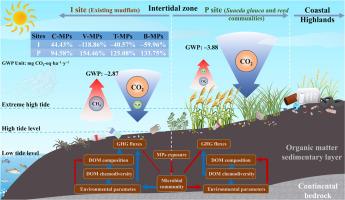Vegetation cover affects the response of greenhouse gas emissions to microplastics in a coastal wetland
IF 12.4
1区 环境科学与生态学
Q1 ENGINEERING, ENVIRONMENTAL
引用次数: 0
Abstract
Microplastics (MPs) pollution in coastal wetlands has become a major environmental concern. Most studies examining the effects of MPs on greenhouse gas (GHG) emissions in these ecosystems have been limited to laboratory-based incubations. Here, we conducted field-based in situ incubation experiments to explore spatiotemporal patterns of GHG emissions under varying levels of MPs and evaluate the regulatory effects of dissolved organic matter (DOM), microbial communities, and vegetation cover. MPs exposure significantly increased GHG emissions (global warming potential, GWP: +107.46%) by restructuring microbial networks, enriching key functional microbial taxa, and reducing the bioavailability of DOM while enhancing its electron transfer capacity (p<0.05). Biodegradable MPs stimulated GHG emissions more than traditional MPs (GWP: 155.87% vs. 71.16%), primarily due to the additional organic carbon substrates they provide and their priming effect on microbial metabolism. Vegetation cover altered the direction of carbon dioxide (CO2) emission responses, increased methane emissions, and affected the mechanistic pathways of nitrous oxide production. Moreover, MPs contributed up to 1.16 Tg of CO2-equivalent carbon emissions annually in China’s coastal wetlands, potentially reducing their carbon sequestration capacity by as much as 15.32% (∼0.12% MPs scenarios). This poses a significant threat to the carbon sink function of blue carbon ecosystems. MPs altered GHG emissions by mediating interactions between DOM chemical diversity and microbial structure and function, and vegetation cover affected the response of GHG emissions to MPs. These findings clarify the effects of MPs pollution on GHG emissions in coastal wetland environments.

海岸带湿地植被覆盖影响温室气体排放对微塑料的响应
滨海湿地的微塑料污染已成为一个重要的环境问题。大多数检查MPs对这些生态系统中温室气体(GHG)排放影响的研究仅限于实验室孵化。在此,我们进行了基于实地的原位孵化实验,以探索不同MPs水平下温室气体排放的时空格局,并评估溶解有机质(DOM)、微生物群落和植被覆盖的调节作用。MPs暴露通过重组微生物网络、丰富关键功能微生物类群、降低DOM的生物利用度和增强其电子传递能力显著增加温室气体排放(全球变暖潜势,GWP: +107.46%) (p<0.05)。可生物降解MPs比传统MPs更能刺激温室气体排放(GWP: 155.87% vs. 71.16%),这主要是由于它们提供了额外的有机碳基质以及它们对微生物代谢的启动效应。植被覆盖改变了二氧化碳(CO2)排放响应方向,增加了甲烷排放,并影响了氧化亚氮生成的机理途径。此外,MPs每年在中国沿海湿地贡献了高达1.16 Tg的二氧化碳当量碳排放量,潜在地使其固碳能力降低了15.32% (~ 0.12% MPs情景)。这对蓝碳生态系统的碳汇功能构成了重大威胁。MPs通过调节DOM化学多样性与微生物结构和功能之间的相互作用改变了温室气体排放,植被覆盖影响了温室气体排放对MPs的响应。这些发现阐明了滨海湿地环境中MPs污染对温室气体排放的影响。
本文章由计算机程序翻译,如有差异,请以英文原文为准。
求助全文
约1分钟内获得全文
求助全文
来源期刊

Water Research
环境科学-工程:环境
CiteScore
20.80
自引率
9.40%
发文量
1307
审稿时长
38 days
期刊介绍:
Water Research, along with its open access companion journal Water Research X, serves as a platform for publishing original research papers covering various aspects of the science and technology related to the anthropogenic water cycle, water quality, and its management worldwide. The audience targeted by the journal comprises biologists, chemical engineers, chemists, civil engineers, environmental engineers, limnologists, and microbiologists. The scope of the journal include:
•Treatment processes for water and wastewaters (municipal, agricultural, industrial, and on-site treatment), including resource recovery and residuals management;
•Urban hydrology including sewer systems, stormwater management, and green infrastructure;
•Drinking water treatment and distribution;
•Potable and non-potable water reuse;
•Sanitation, public health, and risk assessment;
•Anaerobic digestion, solid and hazardous waste management, including source characterization and the effects and control of leachates and gaseous emissions;
•Contaminants (chemical, microbial, anthropogenic particles such as nanoparticles or microplastics) and related water quality sensing, monitoring, fate, and assessment;
•Anthropogenic impacts on inland, tidal, coastal and urban waters, focusing on surface and ground waters, and point and non-point sources of pollution;
•Environmental restoration, linked to surface water, groundwater and groundwater remediation;
•Analysis of the interfaces between sediments and water, and between water and atmosphere, focusing specifically on anthropogenic impacts;
•Mathematical modelling, systems analysis, machine learning, and beneficial use of big data related to the anthropogenic water cycle;
•Socio-economic, policy, and regulations studies.
 求助内容:
求助内容: 应助结果提醒方式:
应助结果提醒方式:


